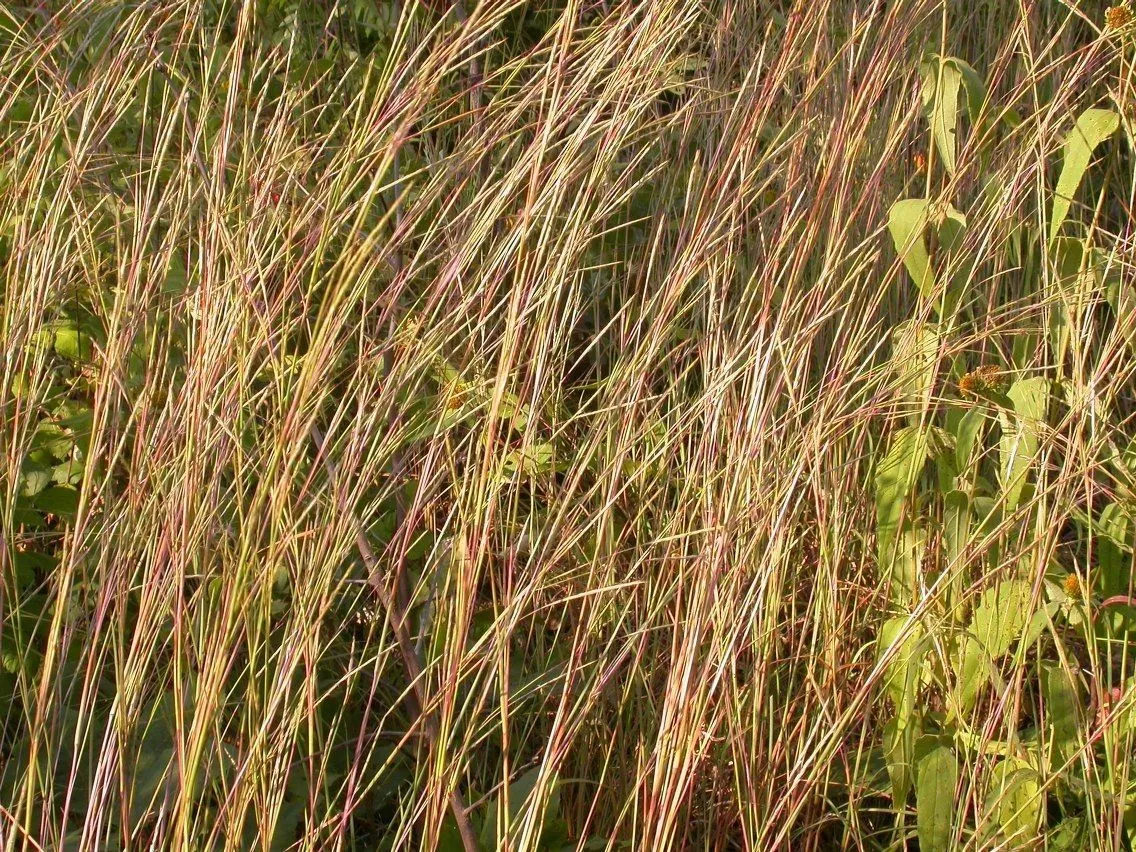
Author: (Michx.) Nash
Bibliography: J.K.Small, Fl. S.E. U.S.: 59 (1903)
Year: 1903
Status: accepted
Rank: species
Genus: Schizachyrium
Vegetable: False
Observations: Canada to Mexico
Prairie beard grass, scientifically known as Schizachyrium scoparium, is a perennial warm-season grass that is native to a vast range extending from Canada to Mexico. This grass is celebrated for its rich historical significance and its vital role in the ecosystems of North America’s prairies and grasslands.
First formally described in detail by botanist J.K. Small in the flora compendium “Flora of the Southeastern United States” in 1903, Prairie beard grass belongs to the Poaceae family—the large and nearly ubiquitous grass family that contains many of the world’s essential cereal crops and pasture grasses.
The species name “scoparium” refers to its broom-like appearance, which is particularly evident in the dense clumps that this grass forms. Standing tall with slender, often blue-green foliage that turns striking shades of red, orange, or bronze in the autumn, it is not only ecologically important but visually pleasing, making it a popular choice for ornamental planting in gardens and landscaping projects.
Ecologically, Schizachyrium scoparium is a keystone species in the prairie ecosystems. It boasts a robust root system that helps prevent soil erosion, thus maintaining soil health and stability. Its presence supports a diverse array of fauna, including various insects, birds, and mammals that depend on it for food and habitat.
Prairie beard grass is notable for its adaptability to different soil types and its tolerance to drought conditions, which enables it to thrive in an array of environments from open plains to wooded areas. The grass’s resilience and its ability to regenerate after disturbances such as fire make it a crucial component in prairie restoration projects.
Beyond its ecological contributions, Prairie beard grass has also played a role in human history. Indigenous peoples and early settlers historically utilized this grass for thatching roofs and other utilitarian purposes owing to its fibrous and durable nature.
Given its wide range spreading from Canada to Mexico, Schizachyrium scoparium represents a critical element of North American biodiversity. Its persistence and adaptability illustrate the remarkable balance of form and function that characterize the Poaceae family, making Prairie beard grass a subject of interest not only for botanists and ecologists but also for anyone invested in the conservation and understanding of native plant species.
Eng: little bluestem, prairie beard grass, broom beardgrass, broom bluestem, small bluestem
Swe: präriegräs
Fra: barbon à balais, schizachyrium à balais
En: Prairie beard grass, Little bluestem, Broom beardgrass, Broom bluestem, Small bluestem
Fr: Barbon à balais, Schizachyrium à balais
Sv: Präriegräs
Taken Aug 17, 2019 by Bob Arnold (cc-by-sa)
Taken Nov 6, 2022 by jasmine oakley (cc-by-sa)
Taken Sep 22, 2022 by RIVER STONE (cc-by-sa)
Taken Sep 22, 2022 by RIVER STONE (cc-by-sa)
Taken Dec 1, 2021 by Phillip Hammond (cc-by-sa)
Taken Dec 1, 2021 by Phillip Hammond (cc-by-sa)
Taken Jan 1, 1900 by EOL − Gerrit Davidse (cc-by-nc-sa)
Taken Jan 1, 1900 by EOL − This image is not copyrighted and may be freely used for any purpose. Please credit the artist, original publication if applicable, and the USDA-NRCS PLANTS Database. The following format is suggested and will be appreciated: Jennifer Anderson @ USDA-NRCS PLANTS Database If you cite (public)
Taken Jan 1, 1900 by EOL − This image is not copyrighted and may be freely used for any purpose. Please credit the artist, original publication if applicable, and the USDA-NRCS PLANTS Database. The following format is suggested and will be appreciated: Jennifer Anderson @ USDA-NRCS PLANTS Database If you cite (public)
Taken Jan 1, 1900 by EOL − Gerrit Davidse (cc-by-nc-sa)
Taken Jan 1, 1900 by EOL − Gerrit Davidse (cc-by-nc-sa)
Taken Jan 1, 1900 by EOL − Gerrit Davidse (cc-by-nc-sa)
Taken Jan 1, 1900 by EOL − Gerrit Davidse (cc-by-nc-sa)
Taken Jan 1, 1900 by EOL − WVU Herbarium (cc-by-nc-sa)
© copyright of the Board of Trustees of the Royal Botanic Gardens, Kew.
© copyright of the Board of Trustees of the Royal Botanic Gardens, Kew.
© copyright of the Board of Trustees of the Royal Botanic Gardens, Kew.
Growth form: Bunch
Growth habit: Graminoid
Growth rate: Moderate
Ph maximum: 8.4
Ph minimum: 5.5
Family: Myrtaceae Author: (F.Muell.) K.D.Hill & L.A.S.Johnson Bibliography: Telopea 6: 402 (1995) Year: 1995 Status:…
Family: Rubiaceae Author: Pierre ex A.Froehner Bibliography: Notizbl. Bot. Gart. Berlin-Dahlem 1: 237 (1897) Year:…
Family: Sapindaceae Author: Koidz. Bibliography: J. Coll. Sci. Imp. Univ. Tokyo 32(1): 38 (1911) Year:…
Family: Asteraceae Author: A.Gray Bibliography: Pacif. Railr. Rep.: 107 (1857) Year: 1857 Status: accepted Rank:…
Family: Fabaceae Author: Medik. Bibliography: Vorles. Churpfälz. Phys.-Ökon. Ges. 2: 398 (1787) Year: 1787 Status:…
Family: Aspleniaceae Author: (Cav.) Alston Bibliography: Bull. Misc. Inform. Kew 1932: 309 (1932) Year: 1932…